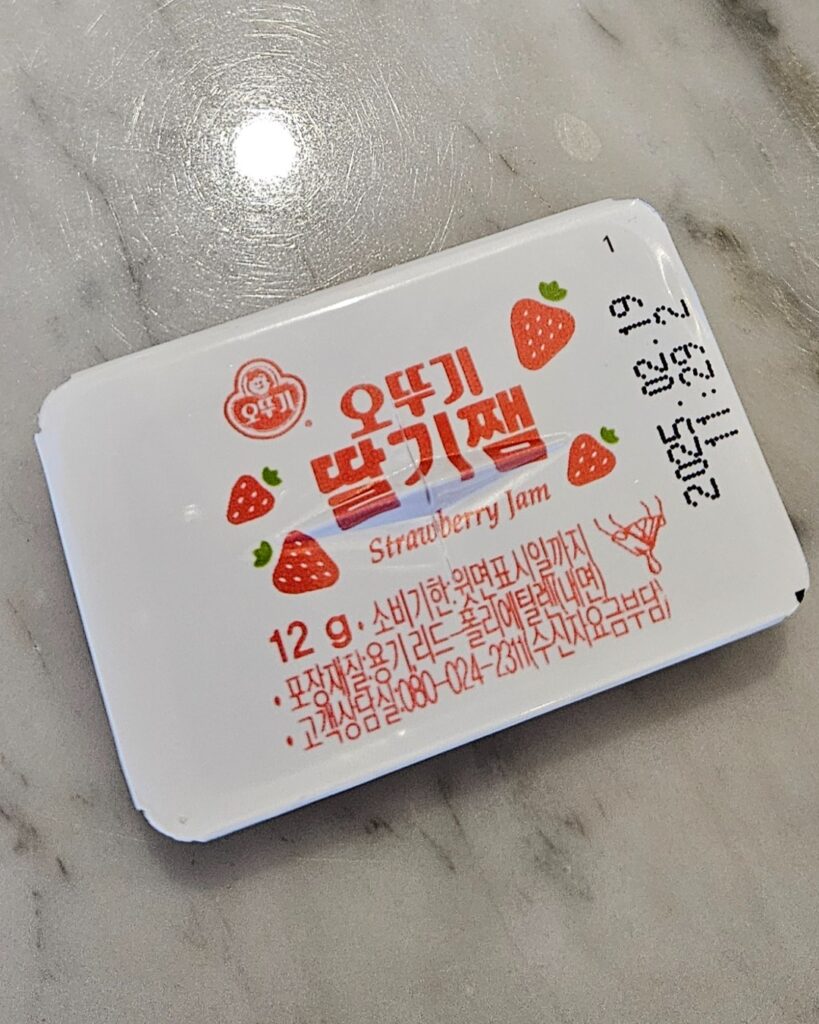
DAY 6
(Reading time: 5 minutes)
In South Korea, we often run into the “selection” problem when it comes to breakfast. A typical Westerner might have sweet or savory pastries, butter, cheese, ham, oatmeal, cereal, eggs, sausages, yogurt… in the morning. Not so for Koreans. Traditional Korean breakfasts don’t really exist. Instead, people pull out some banchan (side dishes featuring a wide variety of fermented vegetables), rice, leftover soup, or maybe fry up some fish or meat—and most of it is spicy because, well, this is Korea. For us, that’s more of a lunch or dinner menu, not something we want first thing in the morning.

(photo for illustration purposes, taken at different hotels)
At hotels, there’s often just one small “Western corner” for breakfast, offering American-style white toast (which is more sweet than savory), mini jam and butter packets, and, if you’re lucky (usually at higher-end hotels), some cereal. Eggs, however, are a world-wide treasure—they’re served everywhere in every imaginable way, for which we’re eternally grateful
So, we went downstairs to the dining area in the morning, only to discover, the horror, that due to a lack of guests, the breakfast buffet—and with it, our Western corner—had been canceled. An ajumma (a term for a middle-aged/older Korean woman, typically with a trademark perm—what we call “grandma”) saw us and started preparing a Korean breakfast without even asking if we wanted it. We could already see the tray filling up with spicy vegetables, kimchi soup with bones, and bits of questionable meat sizzling away… no way! We couldn’t let that happen. I dashed to the reception to explain that we wanted our good ol’ white toast with jam (we don’t even eat it at home, but here, it was our only salvation).
Both the receptionist and the ajumma were shocked—foreigners rejecting Korean breakfast? What should we give them? What do Europeans even eat…?
Of course, we got our toast, and more. It seemed like the ajumma had done some quick googling and ended up serving us fried eggs, some spread, a bit of canned peach compote, and a sweet, tangy yogurt-like drink. Before letting us eat, she carefully arranged everything on trays and took a photo. Next time, she’ll know. 😊 Even we were a bit taken aback—could we really be the first guests ever to refuse a Korean breakfast?
Meanwhile, outside, it was raining for the second day in a row. So, we decided to skip a long journey across the island and opted instead to visit “ponies.” These “ponies” are two lighthouse structures in the shape of—you guessed it—ponies, one red and one white, located on the coast near the airport. It’s about 2 km as the crow flies, but the bus took a detour of about 9 km to get there (around the airport).
The ponies guard the entrance to a small bay that serves as a harbor for smaller boats, shielding them from waves.


From there, we headed to the right along the coastline, where we came across a series of children’s statues representing traditional Korean games. Some games, like jump rope or spinning tops, are familiar to us, but others, such as yutnori, gonggi, cham cham cham, and ddakji, are uniquely Korean. For some, we were glad to read the descriptions because we couldn’t even guess what we were looking at.
The weather granted us a brief pause between downpours, and we used this “dry break” to take a short hike up the nearby volcanic hill (oreum) Dodubong, which offers views of the airport. Given the frequency of flights, there’s almost nonstop entertainment.
At the foot of Dodubong lies the Dodudong Rainbow Coastal Road—a colorful promenade along the coast. Concrete blocks originally served as wave breakers and barriers to prevent cars from veering into the sea. Now painted in bright colors, they’ve become a tourist attraction. The entire stretch takes about 15–20 minutes to walk (whether on the blocks or the sidewalk, your choice), during which you’ll encounter several sea-themed statues (fishermen, pearl divers, etc.).

Our last stop of the day was Dongmun Market. If you want to eat, drink, or shop for local Jeju delicacies to bring home as souvenirs, this is the place to go. We also used its covered area as shelter from another downpour. The market is quite sprawling, and you can easily spend an hour wandering through its lanes, browsing and sampling local goods. One ajumma will offer you everything from homemade kimchi to brooms and slippers; elsewhere, a fish eye winks at you from an aquarium, and someone nearby insists you taste Jeju’s famous tangerines… before you know it, you’re leaving with full belly, hydrated, and with a backpack full of gifts for family and friends. Mission accomplished.
-endy-
DONKEY´S SPECIAL:


Kids divide into two teams and, often through rock-paper-scissors (or a similar method), decide which team will be the “horse” and which will ride it. Riders sit on the backs of the horse team (not pictured here, but imagine more kids sitting on their peers). The horse team’s goal is to buck off the riders, while the riders aim to exhaust the “horse” until it collapses.
-mj-